Work Time
Work time is the heart of Writing Workshop. During work time, children have the opportunity and time to develop their ideas, engage in the writing process, and apply the skills, strategies, and behaviors they are learning about.
Spotlight on Conferences
A spotlight on a share session and for more information on it's importance to the Writing Workshop structure.
Writing is a skill that develops over time and through lots of practice. The more time we give children to write, the better they get at it! The workshop model gives children this much needed practice time.
During work time, children are busy planning, drafting, revising, editing, and publishing their own original pieces. Children may also be researching, discussing ideas, or collaborating with classmates. The specific choices will depend on the age and ability of your writers, as well as the genre of writing you are teaching.
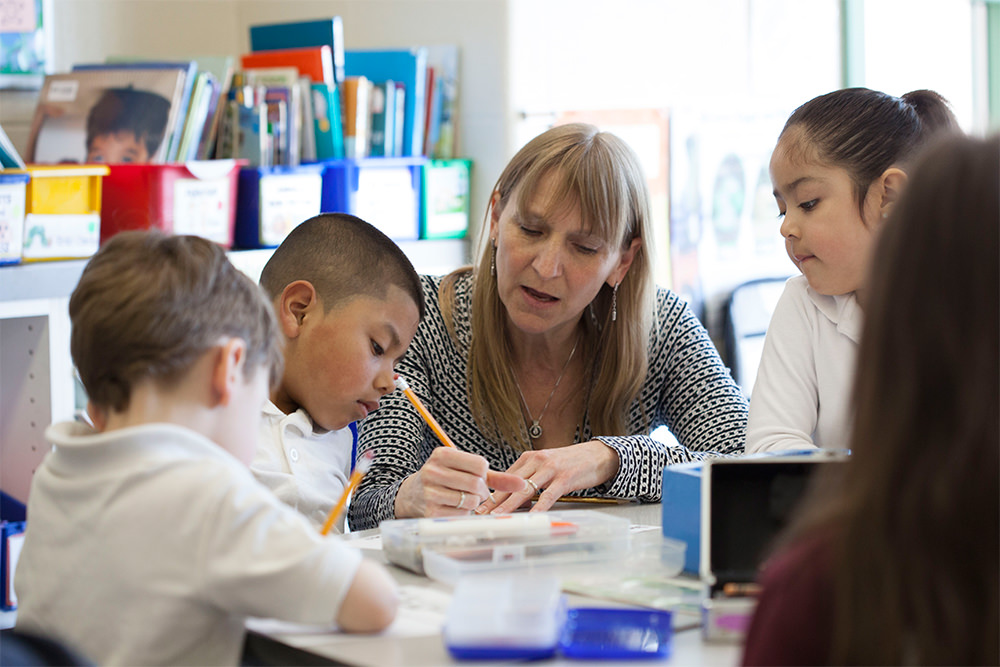
Work time is also your chance to meet children’s needs by working with children individually or in small groups. Holding conferences with a few children each day and teaching guided writing in small groups will help you get to know who your children are as writers. It will allow you to talk to children about their writing and identify their strengths and needs. This important information will help you plan effective instruction and nurture their growth as writers.
All this busy, purposeful activity doesn’t happen magically. For any work time to be successful, you need to create a joyful climate in which growing as a writer is prioritized. Develop procedures that support choice, independence, and peer interaction. Teach procedures explicitly and give children plenty of time to practice them.
What is the teacher doing? What are the children doing?
Work time lends itself well to differentiating instruction, as all children will be working in a way that meets their needs. While work time will look slightly different in each classroom, even from day to day, some elements remain the same. All children can spend time writing independently or privately. They may need to spread out around the room, in chosen or assigned writing spots. Work time might also give them an opportunity to do research, get and give feedback with fellow classmates, and organize notes. With your initial instruction around procedures and regular reviewing of expectations, this time will lead to the development of motivated and hard-working young writers.
| During Work Time, the Teacher Can: | During Work Time, the Children Can: |
|---|---|
|
Conferencing – One on one time is essential for helping young writers to receive meaningful feedback from you. Working with a strategy or guided writing group – Do you have a handful of reluctant writers? Spend the first few minutes of work time attending to their needs as a small group. Ensure they have a plan and know what they will write about independently. Do you have a small group of writers who are all struggling with a similar skill or strategy? Use this time to address this need. For example, you can gather a handful of children whose pictures are not matching their writing and remind them why it is important to do so. “Writers, today I wanted to gather together to help you remember to make sure our pictures match our writing. When our pictures are not connected to the words, our writing can be confusing for other people, and hard to understand. During work time today, I want to remind you to ask yourself the question, “Does this match?” in between the drawing and the writing. Here is a sticky note with the question on it to put in the corner of your desk to help you remember.” As they write, they share a goal of matching pictures to words. Circulating – While you won’t be able to meet individually with every child during every work time, you may have a few minutes to glance at their work and assess their progress. You will want to gather information about where children are in the writing process, and also look for children who have tried out the skill or strategy taught in the mini-lesson to prepare for share time. |
Writing Independently – Children will need time during every Writing Workshop to write. While they will need to engage in other, more social aspects of writing, working independently for an age-appropriate length of time is an important skill and should be a daily activity. Partner Work – As writing is largely about putting our thoughts into words, your children will need to spend time during Writing Workshop talking with their peers about their work. Peer conferencing can be very successful if they are taught explicitly what kind of positive language to use when working cooperatively, and how to help each other in ways that don’t rely on the teacher. Reading the Room – You may have multiple areas of the room that children can use independently to support the writing process. For example, using an interactive word wall, or moving closer to an anchor chart or word bank may help a child to spell accurately. Keep in mind writers find their spark in different ways. Maybe your class has developed an “inspiration wall” to both build community and encourage each other to think of writing topics. During work time, children may be moving around the room to use those resources, help themselves continue to stay focused, and meet goals. Conferencing – While the overall expectation during work time is to write and work through the writing process, children will be engaging in conferences with you, the teacher. During each conference, a child’s needs can be met, and goals set to keep them moving forward. Also, since these conferences will take place wherever the child is working – at their table or desk, or at a designated writing spot – children who are working nearby can also reap the benefits of their neighbor’s conference by listening in. |
Writing Partnerships
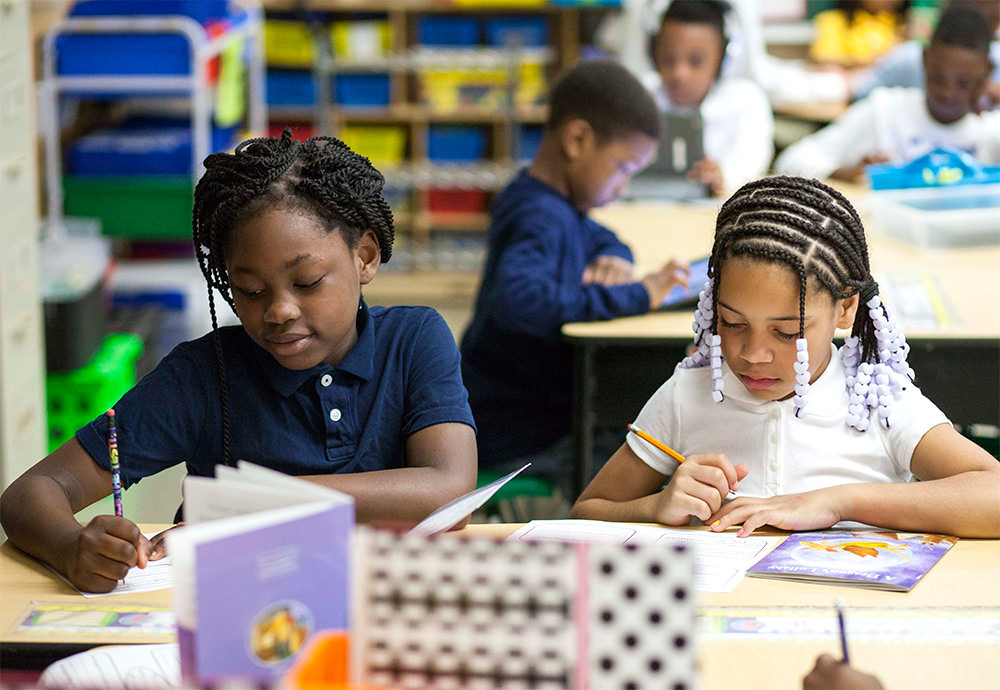
While the act of writing may be a solitary one, writing time itself need not always be done entirely alone. Children are better able to put their thoughts onto paper if they’re given an opportunity to discuss them. While this happens during the have-a-go, some of work time can also be designated for children to talk about their writing together. Being in a writing partnership is an essential element of an engaging Writing Workshop. When children are given opportunities to give and receive feedback and encouragement, it helps them grow as writers and nurtures the classroom community. This reflective talk allows them to think deeply about their own writing, become inspired by others’ choices or advice, and take risks within their work; in other words, to become true authors. Writing partnerships are one tool you can use to strengthen children’s engagement in writing.
Writing partnerships serve many different functions depending on children’s age, literacy experience, language proficiency, and grade level.
Writing partners will spend time reading and talking about each other’s writing. These partnerships are multi-purposeful. They help children learn to talk about their own writing, their goals, and their concerns. But they also support cooperation and self-regulation, and they support strengthening children’s identities as writers. Writing partners do not need to be matched according to ability level in the same way that reading partners are. Recognizing strengths in each other can be meaningful for writers of all levels. One child’s strength may be in including details, while another’s may be organization. It is suggested that writing partnerships are teacher selected. And in order for children to develop relationships with multiple partners, they may sit next to one buddy during the mini-lesson, but be paired with someone else during work time. Many teachers find it helpful to switch writing partners for each genre of writing so that children can get used to developing working relationships with different types of people.
Below are some ideas for mini-lessons that you can teach to support writing partnerships in your classroom.
Mini-lessons around partnerships:
- Partners take turns sharing their work and giving feedback
- Partners coach each other when they need help
- Partners ask each other questions
- Partners give positive feedback or compliments
- Partners offer suggestions to help stories grow
- Partners can solve problems so they can get good writing work done
- Partners look at each other when they talk so they know they’re listening
- Partners think about what the other person is saying so they can answer
- Partners ask questions when they don’t understand what their partner wrote so their partner’s ideas are clear
- Partners help think of new ideas
- Partners can help remember missing details
- Partners have different strengths
- Partners use kind words
As children become more advanced writers, partnerships often evolve. They tend to take place at the end of work time, or during specific revision lessons during each unit. The relationships are generally more focused on personal writing goals, or are based on particular genres of writing (for example, classmates’ biographies). Nevertheless, many, if not all, of the lessons described above would still be relevant, as the ins and outs of working successfully with a partner need to be carefully and explicitly taught.
Managing the Work
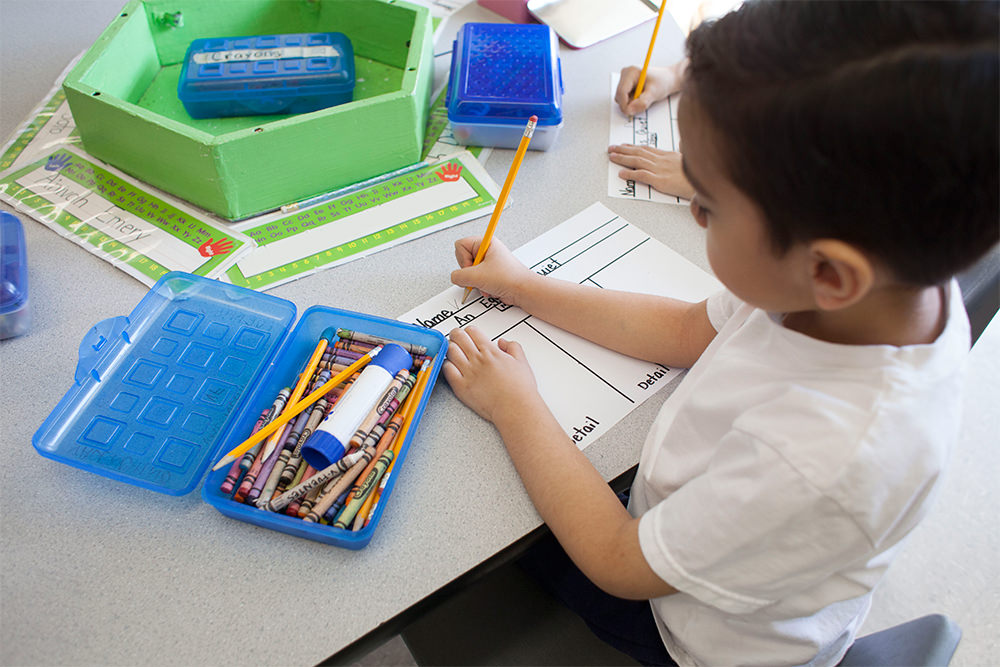
Work time during Writing Workshop is also an opportunity to help your children build independence. As your attention needs to be directed towards individual conferences or small groups, the children are responsible for keeping track of materials they need and relying on each other to answer questions instead of you. Support children to manage their own work and time in the following ways:
Organizing and Using Materials
Keep writing materials in an area that is accessible to children. Make sure you teach them the system you use to help them keep track of their papers or notebooks, so that they can be responsible for helping to maintain it. You may choose to store folders and/or notebooks in magazine racks that will be handed out at Writing Workshop time, or you may have a shelf with different types of writing paper so that they may choose which type best meets their needs.
Teach the procedures for:
- Troubleshooting a broken pencil
- I need more paper
- I need an eraser
- My paper ripped
Some of these lessons will be taught best when you are first kicking off workshop in your class, but others will pop up along the way.
Inspiration
Make sure your children have plenty of ways to choose a writing topic.
- Spend time brainstorming at the beginning of each genre of writing, coming up with different topics that your children may want to write about.
- Create an “inspiration wall” in your classroom on which children can post their ideas written on sticky notes, along with drawings and photographs that may help to inspire your budding writers.
- Encourage your children to look to authors for inspiration. Keep a bin of mentor texts that they can go to for ideas. The books you select to be stored in the bin should be books you have already read aloud that they are familiar with, and should change with each writing genre. For example, if you’re working on narrative, My Rotten Red Headed Older Brother (Patricia Polacco) and Shortcut (Donald Crews) would be great texts to keep handy, while for instructional writing, you may want to laminate some magazine articles or recipes to keep close by.
Spelling
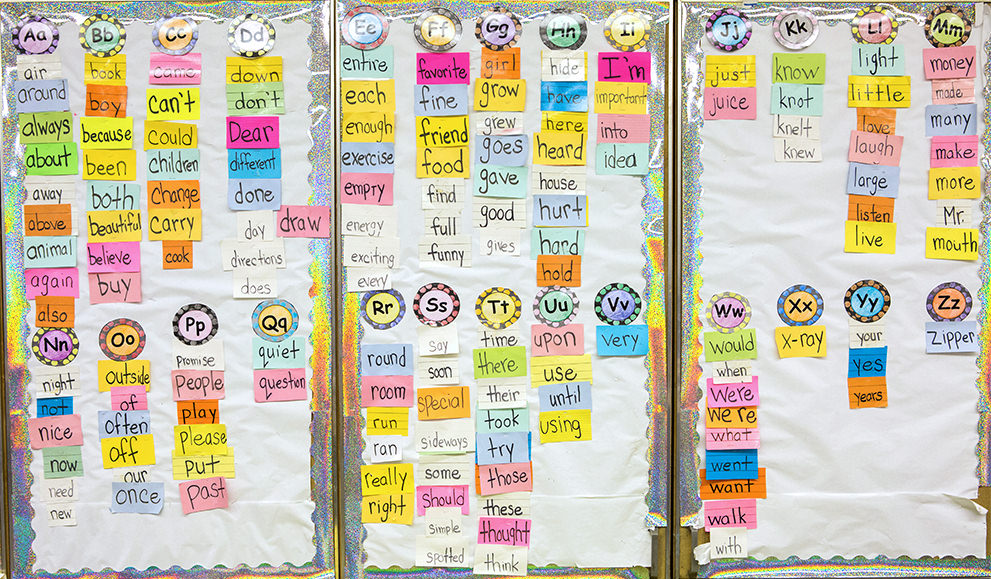
Emphasize to your children that spelling every word accurately is not the top priority during work time. Some children may be used to needing to have perfectly spelled words and may experience initial discomfort with this shift. We can support them in a few ways.
- Word banks – At the start of each season or writing genre, you sit with your children and fill a chart paper with a collection of words they think they may need to know how to spell during work time. Keep the word bank posted during work time, so they can look for words they need independently. If you keep a collection of these word banks in one spot, they can also refer to older ones when needed.
- Interactive word wall – Here’s one more incentive for teaching new sight words each week! Store a small envelope at the bottom of each letter on your word wall, big enough to store Popsicle sticks. Each time you add a word to the word wall, write the same word on a Popsicle stick and place it in the envelope. Teach children how to find the word they are looking for, take it to their writing spot to record it carefully, and then return it to the envelope.
- Circle and come back – When all else fails and the word is nowhere to be found, encourage children to use a stretch-it-out spelling strategy. Teach them to circle the word lightly, as a signal that they can come back to the word later.
Visuals
Use photographs or charts to help children remember how to solve problems. As part of your procedural mini-lessons to prepare them for work time, take pictures of your children working independently, getting themselves a new piece of paper, or getting past the roadblock of a broken pencil.
Anchor Chart Example
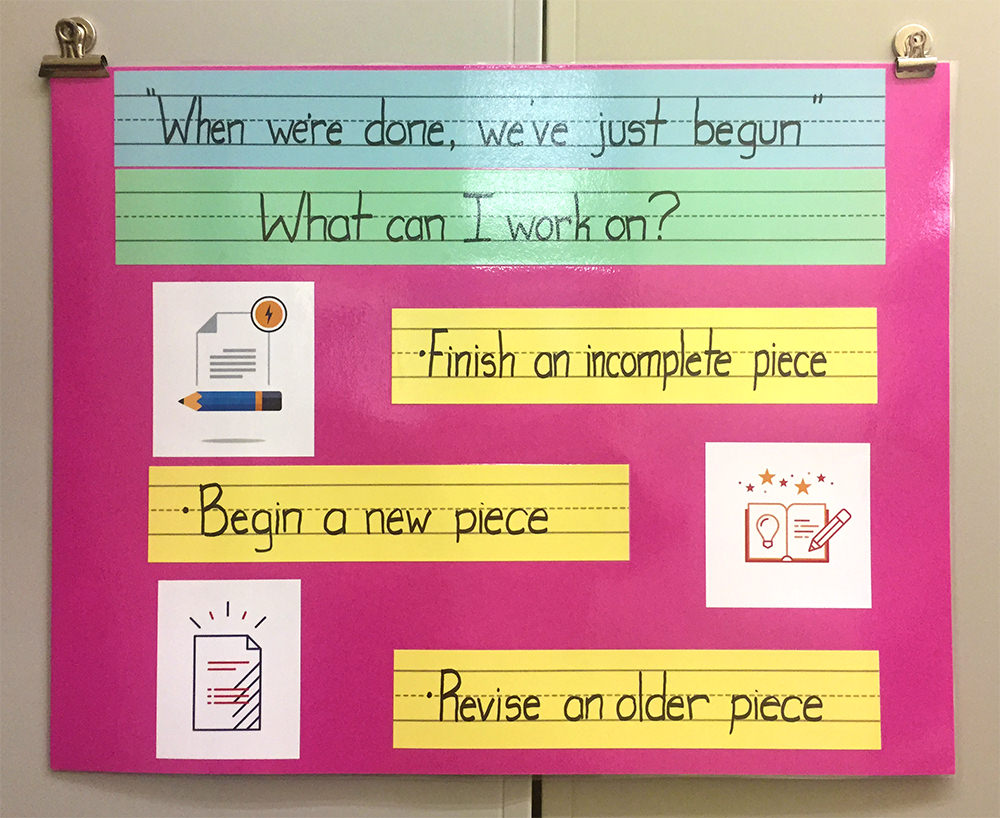
Building Writing Stamina
As the majority of the time you have for your Writing Workshop should be devoted to work time, children will need to work on building their writing stamina. The goal is for children to develop their writing muscle. In order for them to do this, they must get daily practice focusing on writing. Stamina also grows when they become familiar with coming back the next day to continue working on a writing piece. Writers need to know that we don’t rush through the process, but take time to return and look at our work with a reflective lens. Also, as your children acquire new skills and strategies, we want them to spend time making sure their work reflects their abilities. By making the experience of building stamina a whole class experience, you are nurturing them as a writing community.
Create a chart
Create a visual for your children to track their stamina as a class. Draw a bar graph, or thermometer, or even a set of steps, each designed so that you can record dates and time spent writing.
Use a timer
You may want to set a simple egg timer or a digital timer on a projector, for children to check in to see how much time they have remaining in the time allotted for writing. This will help them to plan their moves accordingly. For example, if they finish working a piece with only a few minutes to spare, they may spend the last few minutes adding to a list, or re-reading or revising older writing, as opposed to starting something completely new.
Writing Conferences
Spotlight on Conferences
A spotlight on a share session and for more information on it's importance to the Writing Workshop structure.
A conference is a purposeful conversation between you and one writer. It is designed to allow you to differentiate your instruction to meet that individual child’s needs. It’s also a wonderful time to get to know your children as people, find out about their life experiences, discover strengths, and help them to more clearly express their thoughts.
Because a conference is a conversation, it can feel a little different from other teacher-child interactions. A conference is designed to draw the child out. Through the use of open-ended questions, you learn about the child’s strengths, needs, interests, and goals as a writer. Children need time and practice learning about their role in a conference, so lessons that you teach that clearly explain why you want to talk with them and what you are hoping to accomplish during a conference will be helpful.
Conferences are structured conversations. There’s a general architecture to a conference in order for you to both learn what the child is doing well and how you want them to grow. This architecture helps make the children comfortable; they come to understand the patterns in the conversation, and as a result feel comfortable with the expectations. While the structure empowers children, it might also seem a little unusual for you because of its open-ended nature.
What’s important to remember is that this conference is not the time to “fix” your child’s writing for them, but to focus on a skill or writing technique that will be helpful in the piece they are working on and in the future.
Once you begin talking to children, you’ll find that you will have many ideas for how they might grow. The tricky part is selecting one of those paths. Use your knowledge of the child as they both grow as a writer and are acquiring skills through Writing Workshop, the general needs of writers at that level, and the information you gather from your conversation to help guide your selection of the targeted teaching point.
Typically, conferences last between three and 10 minutes, depending on the age of the children, the topic of conversation, the children’s comfort with this kind of interaction (and yours), and the time of the year. Make sure to keep anecdotal records during your conference so you can track children’s progress and growth. Some teachers also find it helpful to keep a calendar page with them while conferencing, so they can set a date for the next conference with the child and he or she will know when to expect the next formal conversation around their writing “I will check back in with you on Thursday to see how it’s going. Do you think that will be enough time for you to add two details into your beginning, middle, and ending?”. Also, it can help you to ensure you are meeting with all of your children regularly. It’s a good idea to incorporate some flexibility into your schedule, so that children can request or sign up for a conference when they need some extra time with you.
Structure of the Conference
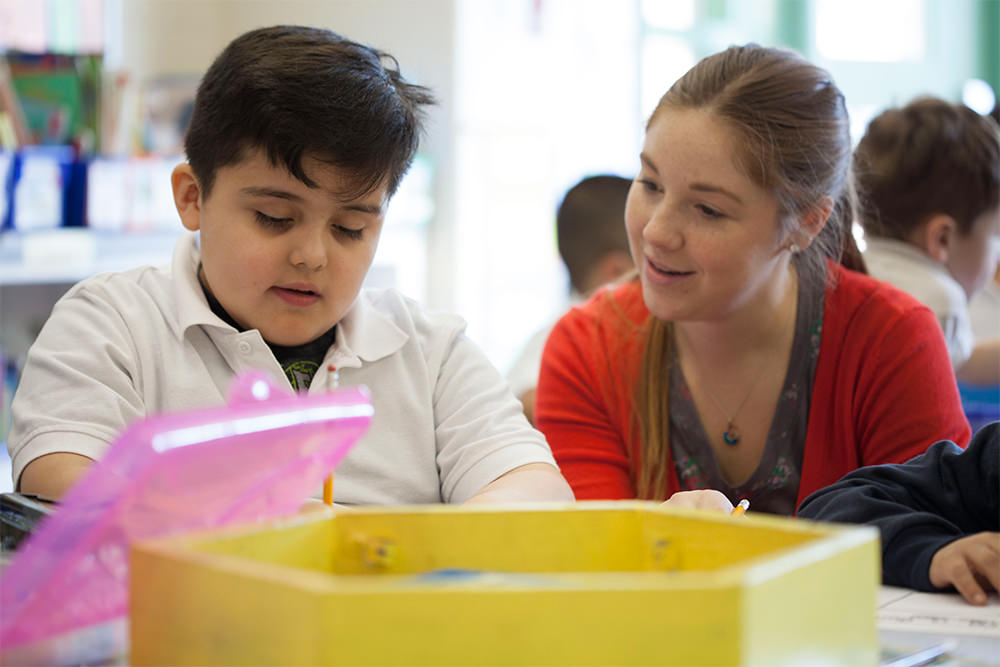
Conferences are opportunities to hold short conversations with individual readers in your room. These are conversations that help you understand your children’s interests and passions, their thought processes as both a writer and as they acquire the language of the craft of writing, their strengths and their needs. They quickly become a favorite time for everyone involved. In order to ensure that your conversations give you the information you need to both learn more about your individual children and help guide them in their reading development, effective conferences typically follow the following structure:
Research → Decide → Praise → Teach
This structure also makes it easier for the children to know what is expected of them and what will take place.
RESEARCH
Begin your conference by asking open-ended questions in order to learn what the child is able to do as writer and what you think the next step might be for the child. For example, “Hi Danielle. Tell me about what you’re working on today. Can you read me what you’ve written so far?”
DECIDE
Now that you have done your research, you need to make some decisions. What is this writer doing well that you can name? Based on what you know about writing development, what skill, strategy, or behavior might you offer this child in order to help them grow? These are decisions you will have to make in the moment, during your conversation.
PRAISE
Name something the child is doing well. Consider how you can relate it to what the child needs to do next.
“Wow, Danielle. You just told me that you are writing about the time that you were sick with strep throat. Your first line made me interested and curious about what happened to you, and it also made me think of a time that I was sick. I can tell you worked hard on crafting a strong lead.”
TEACH
Offer one skill, strategy, or behavior that will help this child move forward as a writer. Remember to “teach the writer, not the writing.” In other words, look for something universal that you can teach, that can be applied regardless of the exact piece or type of writing. You might begin like this, for example:
“I also noticed that you gave just one detail in the middle of your story, about what you did while you were sick at home. To keep your readers interested, and to help them to imagine the same story that you have in your mind, we need to give them lots of details throughout the story. You can use some of the question words to help you think of details to add. Let me show you what I mean. Who? Who was at home with you? What? What did you do all day? How? How were you feeling?”
c. 2009 by Carl Anderson from Strategic Writing Conferences (Portsmouth, NH: Heinemann)

Comments (26)
Log in to post a comment.